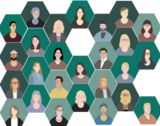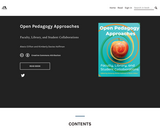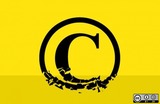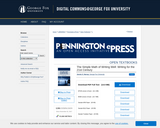
A poster describing similarities and differences between Open Access and Open Education
- Subject:
- Open Educational Resources & Practice
- Material Type:
- Diagram/Illustration
- Author:
- Abbey Elder
- Date Added:
- 10/20/2023

A poster describing similarities and differences between Open Access and Open Education

To understand Creative Commons and the licenses you need to have a basic understanding of copyright.
Copyright is a set of exclusive rights granted to a creator preventing others from copying, distributing, publicly performing, adapting, or doing almost anything else except read/view/listen to a work without the copyright holder's expressed permission. Its purpose is to protect the creator’s rights for a certain period and is granted in our constitution. Copyright, in the United States, is automatic from the moment something original is set in a tangible form that can be perceived by other humans or machines, meaning the moment is written down, recorded, performed for others, etc. Copyright lasts a long time and is balanced between a holder's intellectual property rights and public interests. These public interest exceptions are for parody, criticism, and for a disability as well as anything that falls under Fair Use or the TEACH Act. Copyright is also limited since you cannot copyright facts, figures, or ideas - just the expressions of those things. It also doesn't cover intellectual property that is better protected by patent or trademark law (think inventions or branding).

Open Educational Resources (OER) comprise
learning objects and tools that are freely
accessible through an open license, either
through the public domain or Creative Commons
licensing. Since OER are not beholden to rigid
publisher copyright, educators have agency over
their use of these resources. More specifically,
these open resources align with the 5Rs, which
allow users to retain, reuse, revise, remix, and
redistribute OER content (Wiley 2014)

Creative Commons is a free licensing system that allows the author of a work to specify legal permissions for how the work may be used others, while retaining full copyright to it themselves. Creative Commons licenses are not an alternative to copyright. They sit on the shoulders of copyright law, and allow authors to easily modify copyright terms to encourage collaboration and sharing.

Fleming College faculty and our peers around the world are building a community patchwork of ‘chapters’ into a quasi-textbook about pedagogy for teaching & learning in higher education. Each patch of the quilt/chapter of the book focuses on one pedagogical skill and is completed and published by different individual faculty members from any institution wanting to join in.
Resource is also available in alternative format: https://openfacultypatchbook.org/

This guide provides resources on the topic of Open Pedagogy, as a supplement to the OERTX Digital Information Literacy Hub.

The entire spirit of this book project reflects the editors’ shared belief in the power of an open and inclusive community, of learning, and of collaboration toward innovation. From the outset, the editors knew that this book would be an open project in its own right. It had to be published openly (to practice what we preach), and it would serve as an opportunity to learn the process of creating an open book from start to finish, including, for example, developing review criteria that would ensure rigor, diversity, inclusion, and ingenuity while drawing from the open community to involve both novice and expert OP practitioners both as authors and readers.

This website is designed to serve as a resource for educators interested in learning more about Open Pedagogy.

This toolkit is intended as a guide for students who are engaging in open pedagogy. The toolkit defines open pedagogy, the benefits of open pedagogy, and the rights and responsibilities that come with being a student creator. Instructors may wish to use this toolkit as a resource to scaffold conversations about open pedagogy with their students and to appropriately prepare them for working in the open.

The importance of e-learning tools facilitating the process of learning to program is growing, especially
as the pandemic-caused lockdown enforced distance learning in many countries. The key success
factor in this process is the provision of an instant and relevant feedback to students. In this paper,
we describe a novel open-source programming learning environment featuring automatic assessment
of students’ solutions and customized gamification. This environment has been developed as a part
of the FGPE framework

Open access is a publishing model that enables the free online accessibility of journal articles and scholarship, permitting any user to read and use these works. Open access fuels innovation through knowledge transfer by reducing barriers to reading discovery, and sharing.

This guide provides a primer on copyright and use permissions. It is intended to support teachers, librarians, curriculum experts and others in identifying the terms of use for digital resources, so that the resources may be appropriately (and legally) used as part of lessons and instruction. The guide also helps educators and curriculum experts in approaching the task of securing permission to use copyrighted materials in their classrooms, collections, libraries or elsewhere in new ways and with fewer restrictions than fair use potentially offers. The guide was created as part of ISKME's Primary Source Project, and is the result of collaboration with copyright holders, intellectual property experts, and educators.* "Copyright license choice" by opensource.com is licensed under CC BY-SA 2.0.

This policy is a starting point for institutions wishing to develop accessibility policies and practices for their online courses and is designed as a set of dynamic guidelines rather than a legal document. It was created in response to earlier research done by Frey and King (2010) with QM institutions revealing that 87% of respondents did not have an accessibility policy for online programs.

A short online tutorial to introduce readers to research best-practices in the humanities and social sciences.

Do you struggle with getting your students to use quality, relevant resources in their research assignments? In this session, librarians will share best practices for scaffolding information literacy into your classroom curriculum through Canvas. Information literacy involves recognizing when information is needed and being able to locate, evaluate, and use that information effectively. We will discuss information literacy scaffolding in your syllabi, assignments, rubrics, and resources in your course.

Writing guides abound, but The Simple Math of Writing Well is one of a kind. Readers will find its practical approach affirming, encouraging, and informative, and its focus on the basics of linguistic structure releases 21st-century writers to embrace the variety of mediums that define our internet-connected world. As Harrop reminds us in the opening chapters of her book, we write more today than ever before in history: texts, emails, letters, blogs, reports, social media posts, proposals, etc. The Simple Math of Writing Well is the first guide that directly addresses the importance of writing well in the Google age.

Social data analysis enables you, as a researcher, to organize the facts you collect during your research. Your data may have come from a questionnaire survey, a set of interviews, or observations. They may be data that have been made available to you from some organization, national or international agency or other researchers. Whatever their source, social data can be daunting to put together in a way that makes sense to you and others.

This LibGuide for students provides instruction on how to ethically use AI and ChatGPT for learning.

This module was created in response to an observed need by BranchED and the module authors for efforts to increase the recognition, adaptation, and use of open educational resources (OER) among pre- and in-service teachers and the faculty who work in educator preparation programs. The module's purpose is to position teacher educators, teacher candidates and in-service teachers as empowered content creators. By explicitly teaching educators about content that has been licensed for re-use and informing them about their range of options for making their own works available to others, they will gain agency and can make inclusive and equity-minded decisions about curriculum content. The module provides instructional materials, resources, and activities about copyright, fair use, public domain, OER, and visual literacy to provide users with a framework for selecting, modifying, and developing curriculum materials.

This guide provides resources on the topic of Teaching Digital Information Literacy, as a supplement to the OERTX Digital Information Literacy Hub.